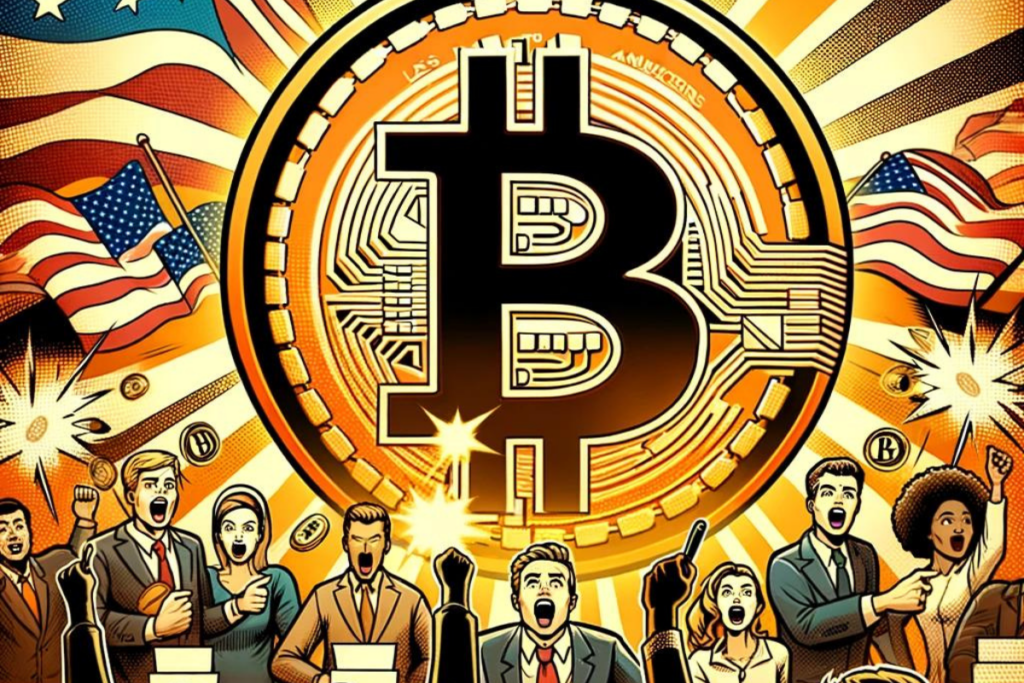Nearly 50% of US voters want cryptocurrencies in their portfolios!
As inflation and geopolitical tensions persist, crypto is gaining popularity among American voters. Nearly half of voters are now considering incorporating these assets into their portfolios. Why this renewed interest and what are its potential consequences on the financial market?

Cryptos appeal to American voters
American voters’ interest in crypto has increased significantly, driven by geopolitical tensions and rising inflation. According to a recent Grayscale study, 47% of voters expect to include crypto in their portfolios, up from 40% at the end of last year. This rise in popularity for these assets, particularly Bitcoin, is largely due to their perception as a hedge against inflation and a reliable alternative to traditional financial systems, which are seen as unstable during periods of economic uncertainty.
This change in behavior is particularly noticeable among younger generations and minority communities, who seek innovative solutions to protect their financial future. Bitcoin, often referred to as digital gold, is viewed as a potentially safe store of value during a crisis. The growing popularity of Bitcoin reflects increased awareness of the benefits offered by crypto and a growing desire to protect against unpredictable economic fluctuations.
Other factors behind this renewed interest
In addition to inflation and geopolitical tensions, several other factors have contributed to this increasing interest in crypto according to the Grayscale survey. These include recent events related to the queen of cryptos. One of the most notable events was the approval of the first Bitcoin Spot ETF in the United States in January 2024. This ETF offers investors a simplified method to access Bitcoin without the complexities of direct ownership.
By making Bitcoin more accessible to both institutional and individual investors, this approval not only legitimized the crypto but also strengthened market confidence in its stability and reliability. This decision by US regulators has boosted demand and attracted a new segment of investors who now see Bitcoin as a reliable component of their financial portfolios.
Another key factor is the April 2024 halving that reduced mining rewards by half and decreased the rate of new Bitcoins being created. This reduction in supply, combined with increasing demand, has historically led to a significant increase in Bitcoin’s price. The anticipation of this event has attracted many investors looking to capitalize on the scarcity dynamic, further enhancing interest and engagement in Bitcoin. These two events have thus strongly contributed to the rise in voter interest in crypto in 2024.
The increase in voter interest in crypto suggests a shift towards wider adoption. In the future, this could lead to significant developments in financial regulations and technological innovation, thereby shaping the digital economy in a sustainable way.
Maximize your Cointribune experience with our "Read to Earn" program! For every article you read, earn points and access exclusive rewards. Sign up now and start earning benefits.
Diplômé de Sciences Po Toulouse et titulaire d'une certification consultant blockchain délivrée par Alyra, j'ai rejoint l'aventure Cointribune en 2019. Convaincu du potentiel de la blockchain pour transformer de nombreux secteurs de l'économie, j'ai pris l'engagement de sensibiliser et d'informer le grand public sur cet écosystème en constante évolution. Mon objectif est de permettre à chacun de mieux comprendre la blockchain et de saisir les opportunités qu'elle offre. Je m'efforce chaque jour de fournir une analyse objective de l'actualité, de décrypter les tendances du marché, de relayer les dernières innovations technologiques et de mettre en perspective les enjeux économiques et sociétaux de cette révolution en marche.
The views, thoughts, and opinions expressed in this article belong solely to the author, and should not be taken as investment advice. Do your own research before taking any investment decisions.